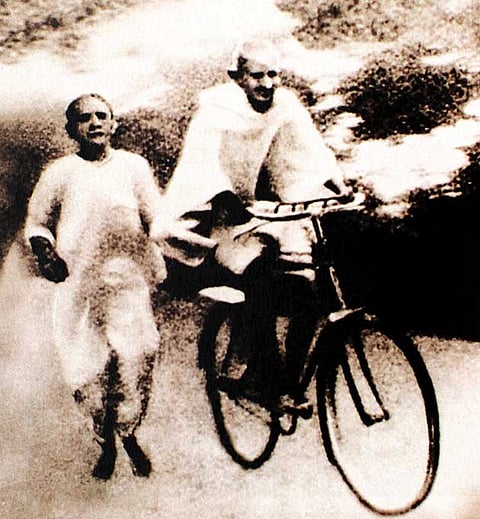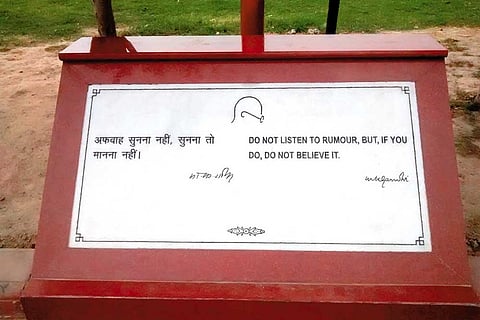When leaders of the stature of Gandhi, Nehru and Jinnah spoke during the pre-Independence days, there was rarely any voice of dissent among the other leaders who dominated the national scene at that time. It was even more non-negotiable when it came to Gandhi’s much-vaunted stand on non-violence. In February 1946, a year and half before the country’s Independence, the mutiny in the Royal Indian Navy, which began as an incitement to arms and call for takeover of British naval establishments, was in every respect contrary to all that Gandhi believed in. It was not surprising therefore that the movement was crushed when it was almost at its peak.
Gandhi@150: The Sailors Who Rocked The Empire’s Ship
If Gandhi and other leaders had supported the Royal Indian Navy mutiny, would our history have been different?
The Indian sailors of the HMIS Talwar, a shore signal school in Colaba, Bombay, rose up in revolt on February 18, 1946, sending shock waves across the British establishment. The Indian mutineers were a small group of combatants against the awesome might of the British Empire. But Gandhi and several other freedom fighters were opposed to it. Why?
The Allies had won World War II. So, it was a stirring sight for thousands of Indian nationalists to see the Indian mutineers lower the Union Jack as part of their mutiny and hoist flags of the Congress, Muslim League and Communist party on most of the Royal Indian Navy ships run by Indian crews with British officers and commanders. Several guns on these ships captured by mutineers were trained on British establishments, including the Gateway of India and the Yacht Club, virtually a challenge thrown to the British.
What the sailors (or Ratings as they were called) were lacking in arms and arsenal, they made up with their fighting spirit and later support from large sections of the middle class, mostly mill workers and students in Mumbai. The revolt had spread from the shores of Bombay to Karachi, Aden to Indonesia. Twenty thousand sailors were involved in 78 British-owned ships and establishments. At the end of it all, over 300 people lost their lives in clashes between the police and public on the streets of Bombay. The cause of the revolt? The poor working conditions meted out to Indian sailors, an element of racism and the overall spirit of anger against British rule, which was clearly coming to an end.
The timing of the naval mutiny upset several prominent leaders like Gandhi and Sardar Vallabhbhai Patel, who was clear that there should be a smooth transfer of power, and freedom should not have to be wrested from the British by a bloody upheaval. But the Communists were the sole exception. A call for hartal was given by the Communist party to all mill workers and students, which led to a rampage across Bombay. On behalf of the Bombay Committee of the Communist Party of India, D.S. Vaidya, secretary of the committee, issued a statement giving the call of hartal on February 22 and appealed to people, including workers, students and shopkeepers, to observe a complete strike and start negotiations to redress the just demands of RIN Ratings. There were, however, others who felt that if the British Navy took strong action, it would delay what was considered inevitable—the handing over of power to the Indian leaders.
The silence among the country’s leaders who fought for Indian independence was deafening. It was clear that at this critical point, no one wished to rock the boat. However, one leader mustered the gumption to stand up for what she believed in and that was none other than Aruna Asaf Ali, later to become a leading light of the Communist Party. Ali turned out to be a fierce dissenter and ranged against the conspiracy of silence manifested by some of the most outspoken leaders who had fought for the country’s independence.
The statements of several leaders at the time of the naval mutiny are indeed revealing. Most of them supported what they claimed was a just outcome of the treatment meted out to them by their British superiors. At the same time as the confrontation between the British establishment and the Indian sailors intensified, Indian political leaders soft-pedalled the issue.

Royal Indian Navy Mutiny, 1946.
Clearly, national sentiment was rapidly rising in favour of the mutineers and the leaders realised it would not do to go against the tide and so, on one level, they were in sync with the spirit of the movement. As Maulana Azad said, “India is not in a mood to tolerate any action that may even have the semblance of the suppression of the national spirit in any quarters.”
As expected, the British Commander-in-Chief, Sir Claude Auchinleck, condemned politics in the armed forces. He was referring to the Indian naval uprising. “It matters not what form collective disobedience takes—whether negative, such as refusal to work or refusal to eat, or positive, such as demonstrations...The milder forms of insubordination are infectious and can easily lead to violence,” he wrote. For the British, there was little difference between the non-violent Gandhian approach and the resort to create a mutiny of sorts.
Meanwhile, Jawaharlal Nehru gave a fitting reply. He said, “If politics meant the love of freedom, he was 100 per cent with politics in the army.” In India, he pointed out that there was a conflict between the duty of a man as a soldier and as a citizen. But in such a conflict, he was of the view that “it would be fit if the duty of fighting for freedom prevailed over the duty of obedience for his superiors.”
It was clear that the Congress leaders, while condemning the violence that followed the mutiny, did not want to be seen as disassociated from the movement. On March 1946, after the Ratings mutiny was crushed, Sardar Patel wrote thus in the Free Press Journal, a paper which supported India’s freedom struggle: “It was not without the greatest difficulty that I persuaded the Ratings to surrender unconditionally, giving them the assurance that whatever their just cause, would be championed by the Congress.” He seemed worried that the acts of violence, which he condemned, should not delay the process of granting India’s independence.
Aruna Asaf Ali, the lone and open supporter of the mutiny, continued to draw flak for her stand. A firebrand leader, close to both Gandhi and Nehru, she was part of the socialist-leaning faction of the Congress party and an Indian independence activist. Widely remembered for hoisting the Indian national flag at the Gowalia Tank Maidan in Bombay during the Quit India Movement, 1942, Aruna became Delhi’s first mayor and remained active in politics even after Independence.
Although Aruna was a huge supporter and follower of Gandhi, she could not resist publicly getting into a spat with the Mahatma, an act considered as open defiance. While commenting on the mutiny, Gandhiji remarked, “If the Indian members of the navy know and appreciate non-violence…why should they serve if the service is humiliating to them or India?” Aruna retorted that she was unable to understand Gandhiji calling upon the Ratings to resign if their conditions were humiliating. “If they did, they would have given up their only means of livelihood. Moreover, they were fighting for principles….”
Aruna also hit out at the lack of Hindu-Muslim unity and proposed that the Royal Indian Navy mutiny could bring both groups together. “She would rather unite Hindus and Muslims at the barricade than on the constitutional front.” Gandhiji refuted the idea as a misleading proposition. He said “the attempt to foster Hindu-Muslim unity through the struggle of the Ratings was not honest, which is also an insult of their struggle for the freedom of the country.”

Gandhi cycling from Gujarat Vidyapith to Sabarmati Ashram (1928).
As the situation was becoming tense, Aruna sent a telegram to Pandit Nehru. The telegram read as follows: “Naval strike, tense, situation serious, climaxing to close, You alone can control and avoid tragedy. Request your immediate presence in Bombay.”
So incensed was Sardar Patel at this that he wrote to Gandhi about Aruna. In a letter to Gandhi, Sardar Patel expressed shock that she had persuaded Nehru to come to Mumbai to meet the sailors. Patel wrote: “She sent a telegram to Jawaharlal and gave out to the Press that under such circumstances, Jawahar was the only leader who could lead them. This she did as she could not find my support. Jawahar wired me asking if his presence was necessary; and in that case, he would come, setting aside all his preoccupations. I advised him not to come. Yet he is reaching here. He has wired back to me telling that he was feeling out of sorts and that he would come. He will come here at 3 pm. Well! Let him. But the fact that he comes here on account of Aruna’s telegram is sorrowful indeed! This way she is encouraged and if we would not resist their rashness, things will go from bad to worse.”
Nehru took the first train to Bombay. But he was persuaded by Vallabhbhai Patel not to meet the striking Ratings. Nehru left for Allahabad the same night. That led to the beginning of the collapse of the naval mutiny. Pressure was being built around the sailors to surrender. Finally on February 23, 1946, M.S.Khan, head of the National Central Strike Committee, made an announcement: “In the present unfortunate circumstances that have developed, the advice of the Congress to the RIN Ratings is to lay down arms and go through the formalities of surrender which have been asked for.” M.A. Jinnah of the Muslim League also made an appeal to the Ratings to not be exploited by those who wanted to use the strike for their own needs. “I appeal to the men and Ratings to call off the strike and to the public in general not to add to the difficulties of the situation.”

If Gandhi and all the leaders had supported the mutineers, would India’s pre-Independence history have been different? Could we have prevented a bloodbath? Finally on February 23, 1946, at 6 am, the mutineers succumbed. They passed a resolution asserting ‘Surrender’, which was placed before the meeting. They had composed a surrender document, the last few lines of which read: “Our strike has been a historic event in the life of the nation. For the first time, the blood of the men in services and the people flowed together in a common cause. We have not surrendered to the British. We have surrendered to our own people. We in services will never forget this.” The surrender document was said to be drafted by Mohan Kumaramangalam, a Communist leader. Sardar Patel assured all the mutineers that there would be no victimisation. But even after Independence, the Ratings continued to suffer and were never given recognition like their counterparts in the Indian National Army for their role in the freedom struggle.
(Views are personal)
Tags